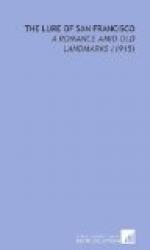Telegraph Hill of Unique Fame
“Would you like to go up ’crazy owld, daisy owld Telegraft Hill’,” I asked in a softened mood as we moved away. “There is just about time.”
“Indeed I should,” he answered. “Can we take in some of the other things you archaeologists were mentioning on the way? I don’t want to miss anything.”
“We must leave the Parrott and Niantic buildings until some other day, but you can see the Montgomery Block if you wish,” and we turned down Washington Street. “It was built on piles, by General Halleck’s law firm. William Tecumseh Sherman’s bank was nearby, but I suppose most of Boston’s business men were generals-in-chief of the United States Army.”
My irony was ignored and as we reached the corner of Montgomery, I continued: “It was on this spot that James King of William, editor of the ‘Bulletin,’ was shot down by James P. Casey, the ballot-box stuffer. The newspaper office was at the other end of the block on Merchant Alley, and that evening’s editorial accused Casey of electing himself supervisor and stated that he was an ex-convict from Sing Sing. Within an hour after the paper appeared, Mr. King was carried dying to his room in the same building. It was this murder that brought the second Vigilance Committee into existence. While the immense funeral cortege, the largest San Francisco has ever known, escorted the body of Mr. King up this street toward Lone Mountain Cemetery, Casey and Cora, another criminal, were hung in front of the Vigilance, Headquarters on Sacramento near Front.”
“You called it Fort Gunnybags ?” he queried.
“Yes, it was so named from the precautionary bulwark of sand-filled sacks piled up in a hollow square in front to protect the entrance. A bronze plate marked the old building before the fire.”
We turned into Columbus Avenue. “Your beloved Stevenson used to live at No. 8, there on the gore where the Italian Bank is,” I said. “We are coming to the Latin Quarter, a section that has always been given over to foreigners, for in early days ‘Sidneyville,’ peopled by ticket-of-leave men from the penal colony of Australia, and ’Little Chile’ of the Peruvians and Chileans, clustered close around the base of Telegraph Hill.”
“The very place Stevenson would choose, where life was flavored with history and the mystery of the foreign. But where are you going?” he exclaimed, stopping short as I began to ascend the steps by which Kearny Street climbs the hill.
“I thought you wished to see the site of the Marine Signal Station.” I looked down at him from the fourth stair with feigned surprise.
“I do, indeed, but—can’t we go up by a funicular and come down this way?” he compromised. “My Boston calves protest.”
“Oh well, we can go by the level a little farther, but I thought you liked the ‘flavor of the foreign.’ Anyway, we ought to see Earl Cummings’ old man,” I remembered.




